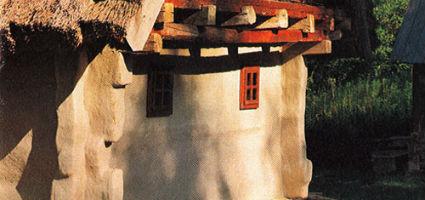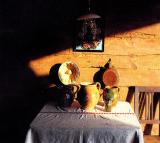2025. July 19. Saturday
Open Air Museum - Gerersdorf
 |
Address: 7542, Gerersdorf 66
Phone number: (3328) 32-255
Opening hours: 01.04-10.31.: Mon-Fri 9-17, Sat-Sun and High day 10-18
|
Even three decades ago, there were only ploughlands here. Soil ploughed by Maria Muik by herself until her death in 1965. She owned the tiny peasant house with straw roof. The neighbouring estate is the location of the open-air exhibition.
Gerhard Kisser of Vienna bought this estate overwhelmed with the beauty of straw roof houses. (That have been dilapidated apace beginning in the 1970's.) In 1973 Gerhard Kisser made his dream come true when he rebuilt a house in Tschanigraben (Sándorhegy). The vine-dressed house in Deutsch ehrensdorfwas rebuilt as a kitchen house (unfortunately, it burnt down in 1996), and another house became the "house of children". Gerhard Kissers hobby soon became the rebuilding of houses and collecting records of the past. Ever since the, he spent all he has ever earned on the "case".
He bought further wooden buildings and moved them to Geresdorf saving them from demolition. Thanks to voluntary helpers, he set up six houses by 1976 named "Ensemble Geresdorf" that he could open for visitors, too. Throughout the years, the "Ensemble Geresdorf" turned into a "village in village" that is one of the biggest open-air museums in Burgenland nowadays.
Most of the buildings are made of soil, wood and hay. Wood cut by handiwork were stuck together with soil. The soil and the hay roof served as excellent dielectric. Up until the 20th century, hay was used by the poor for roofs. However, due to weather adversity, hay roofs had to be taken down and new one had to be put on every 25 years and nowadays this is really expensive.
Appliances and tools were from South Burgenland mainly, but some from West- Hungary, too.
The "Circle of Friends of Ensemble Geresdorf Open-Air Museum" considers it its task to maintain the museum and further its development.
Gerhard Kisser of Vienna bought this estate overwhelmed with the beauty of straw roof houses. (That have been dilapidated apace beginning in the 1970's.) In 1973 Gerhard Kisser made his dream come true when he rebuilt a house in Tschanigraben (Sándorhegy). The vine-dressed house in Deutsch ehrensdorfwas rebuilt as a kitchen house (unfortunately, it burnt down in 1996), and another house became the "house of children". Gerhard Kissers hobby soon became the rebuilding of houses and collecting records of the past. Ever since the, he spent all he has ever earned on the "case".
He bought further wooden buildings and moved them to Geresdorf saving them from demolition. Thanks to voluntary helpers, he set up six houses by 1976 named "Ensemble Geresdorf" that he could open for visitors, too. Throughout the years, the "Ensemble Geresdorf" turned into a "village in village" that is one of the biggest open-air museums in Burgenland nowadays.
Most of the buildings are made of soil, wood and hay. Wood cut by handiwork were stuck together with soil. The soil and the hay roof served as excellent dielectric. Up until the 20th century, hay was used by the poor for roofs. However, due to weather adversity, hay roofs had to be taken down and new one had to be put on every 25 years and nowadays this is really expensive.
Appliances and tools were from South Burgenland mainly, but some from West- Hungary, too.
The "Circle of Friends of Ensemble Geresdorf Open-Air Museum" considers it its task to maintain the museum and further its development.
